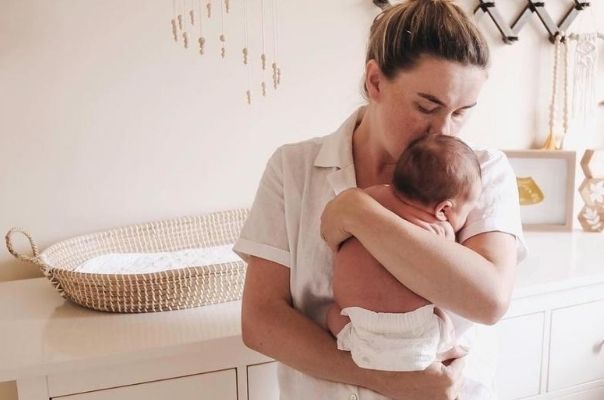Understanding baby growth charts and the wide range of ‘normal’

Because every baby grows at a different pace.
During pregnancy it can seem like you are constantly weighed and measured – then just when you thought the scales and tape measure were being put away, the growth spotlight switches to your bub and you enter the new world of the baby growth chart.
As parents, we watch as our tiny newborns grow and change week-by-week and while it’s miraculous to have a front row seat to these physical changes, many of us can’t help but compare our baby with others the same age while anxiously plotting the lines on the chart.
And so opens a new world of questions. Is my baby gaining enough weight? When should I buy the next size of nappy? Why is my baby not putting on as much weight as my friend/sister/neighbour’s baby? And what even is a “percentile”?
Firstly, all the experts encourage us to remember that each child grows and develops at a different rate – and that weighing and measuring is only one of the markers to check in on your baby’s development.
The most important thing is that your child is healthy, responsive, growing and (mostly) happy.
To help put your mind at ease, here are the answers to the most common questions about how your baby grows.

As a new mum, it’s important to remember each baby grows at a different pace.
What is a baby growth chart?
An infant growth chart helps you and your health professionals keep track of how your baby is growing. These are different charts for boys and girls, for infants and older children.
Growth charts record changes in your baby’s length, weight and head circumference. The measurements are recorded onto a chart so you can track your little one’s physical development.
Babies come in all weights and lengths and have growth spurts and plateaus, so the general idea is that the line on your baby’s graph continues to go up on a fairly constant trajectory.
What does my baby’s percentile mean?
The baby growth chart shows which percentile your child is in compared with others of the same age and gender. Percentiles are shown as curved lines. For example, if your child is in the 70th percentile for length-for-age, this means 30 percent of babies the same age and gender are longer, and 70 percent are shorter.
Also remember, there is a wide range of healthy sizes and lengths, and many factors influence your child’s growth, including genetics, environmental factors, nutrition, activity levels, and health problems. When babies have growth spurts also varies.

Your baby’s length, weight and head circumference will be measured from birth and these measurements are recorded on a growth chart.
Why has my newborn lost weight?
It is normal for a newborn to lose up to 10 per cent of their birth weight in the first week or so, when they pass meconium (the first bowel movement) and surplus fluid.
A full-term baby has plenty of reserves to cope with this initial weight loss, and will soon put on weight once feeding is established.
Due to the low rate of energy absorption in the first few days of your baby’s life, this weight regain often takes 10 to 14 days.
Most babies then gain somewhere between 150g and 400g per week over the first three months.
If you’re concerned about your baby’s weight gain, speak to your doctor or early childhood nurse for further advice.
How do I know when to move my baby up a nappy size?
The size guidelines on the side of a nappy box are helpful for providing a general indication of what size is right for your baby based on their weight.
You will want your baby in a nappy that fits comfortably and has no leaks or blowouts.
Carolina Trujillo, Senior Product Developer from Huggies says “The weight ranges were developed to help us design products that are the right fit and absorbency for baby’s stage of development”
According to Carolina, the key signs your baby needs to go up a nappy size are:
- Your baby’s nappy experiences leakage
- You see some red marking around your baby’s legs
- The nappy is getting tight around the waist

You will want your baby in a nappy that fits comfortably and has no leaks or blowouts.
How many nappies do you need each week?
The amount of nappies you will need varies from baby to baby and from day to day. It’s important to change your baby’s nappy frequently to keep them comfortable – and as soon as possible whenever it’s soiled.
Leaving it too long can result in your baby developing nappy rash.
In most instances, a pattern of regular daily nappy changes will soon emerge and you can expect to be changing your baby every morning after they wake up, before you put them to bed at night, after a bath and also after feeds during the day.
Carolina Trujillo from Huggies says, “Up to 10 nappies a day is a rough guide to the frequency of nappy changes for a newborn during their first six weeks. This decreases to around six to eight until six-to-nine months old. Then, it can go down to four or five nappies a day.”
The numbers from Huggies below shows by size an estimate of how many nappies will be required per week. Newborns need significantly more nappies in those first weeks and some babies can grow quite quickly, so you don’t want to stock up on too many Size 1 as before too long your bub will be into a Size 2.
Size 1: 0-5 kg
60 nappies
Size 2: 4-8 kg
49 nappies
Size 3: 6-11 kg
42 nappies
Size 4: 10-15 kg
38 nappies
Size 5: 13-18 kg
32 nappies
Size 6: 16+ kg
28 nappies

Huggies Newborn Nappies are specifically designed for delicate newborn skin through Huggies 3-way combination of softness, dryness and breathability and its Breathe Dry® Technology which keeps baby’s skin dry and is clinically proven to help prevent nappy rash.
Brought to you by Huggies.




